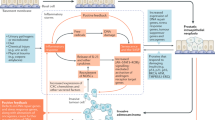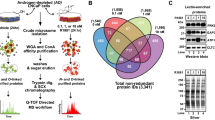Abstract
Prostasomes, prostatic secretory vesicles found in human ejaculates, were analyzed to verify the existence at their surfaces of enzymes involved in the degradation of the extracellular matrix. Findings were compared with those of prostasomes isolated from two human adenocarcinoma cell lines that reflect clinical features and molecular pathways of androgen-insensitive and hormone-responsive prostate cancer. Our aim was to determine whether neoplastic transformation is accompanied by changes of glycosidase and protease activities. Our results show that decreases of dipeptidyl peptidase IV and increases of urokinase plasminogen activator and cathepsin B are consistent with the clinical features of the cell lines, whereas increases of glycosidase activities seem to be of scarce biological significance.
This is a preview of subscription content, access via your institution
Access options
Subscribe to this journal
Receive 4 print issues and online access
$259.00 per year
only $64.75 per issue
Buy this article
- Purchase on Springer Link
- Instant access to full article PDF
Prices may be subject to local taxes which are calculated during checkout
Similar content being viewed by others
References
Ronquist G, Nilsson BO . The Janus-faced nature of prostasomes: their pluripotency favours the normal reproductive process and malignant prostate growth. Prostate Cancer Prostatic Dis 2004; 7: 21–31.
Ronquist G, Brody I . The prostasome: its secretion and function in man. Biochim Biophsys Acta 1985; 822: 203–218.
Utleg AG et al Proteomic analysis of human prostasomes. Prostate 2003; 56: 150–161.
Wilson MJ et al. Dipeptidyl peptidase IV activities are elevated in prostate cancers and adjacent benign hyperplastic glands. J Androl 2000; 21: 220–226.
Schrimpf SP et al. Identification of dipeptidylpeptidase IV as the antigen of a monoclonal anti-prostasome antibody. Prostate 1999; 38: 35–39.
Pro B, Dang NH . CD26/dipeptidyl peptidase IV and its role in cancer. Histol Histopathol 2004; 19: 1345–1351.
Gonzalez-Gronow M et al. Interaction of plasminogen with dipeptidyl peptidase IV initiates a signal transduction mechanism which regulates expression of matrix proteinase-9 by prostate cancer cells. Biochem J 2001; 355: 397–407.
Nobuhisa T et al. Heparanase expression correlates with malignant potential in human colon cancer. J Cancer Res Clin Oncol 2005; 131: 229–237.
Wickramasinghe NS, Nagaraj NS, Vigneswaran N, Zacharias W . Cathepsin B promotes both motility and invasiveness of oral carcinoma cells. Arch Biochem Biophys 2005; 436: 187–195.
Yang SF et al. Increased plasma levels of urokinase plasminogen activator and matrix metalloproteinase-9 in nonsmall cell lung cancer patients. Clin Chim Acta 2005; 354: 91–99.
Nilsson BO et al. Distribution of prostasomes in neoplastic epithelial prostate cells. Prostate 1999; 39: 36–40.
Sahlen GE et al. Ultrastructure of the secretion of prostasomes from benign and malignant epithelial cells in the prostate. Prostate 2002; 53: 192–199.
Delves GH, Stewart AB, Lwaleed BA, Cooper AJ . In vitro inhibition of angiogenesis by prostasomes. Prostate Cancer Prostatic Dis 2005; 8: 174–178.
Tappel A . Lysosomal and prostasomal hydrolytic enzymes and redox processes and initiation of prostate cancer. Med Hypotheses 2005; 64: 1170–1172.
Costanzi E et al. Lysosomal hydrolases in serum from human immunodeficiency virus-infected patients. Clin Chim Acta 1996; 255: 57–65.
Minelli A et al. CD26 and adenosine deaminase interaction: its role in the fusion between horse membrane vesicles and spermatozoa. Biol Reprod 1999; 61: 802–808.
Aisa MC, Beccari T, Costanzia E, Maggio D . Cathepsin B in osteoblasts. Biochim Biophys Acta 2003; 1621: 149–159.
Achkar C, Gong QM, Frankfater A, Bajkowski AS . Differences in targeting and secretion of cathepsins B and L by BALB/3T3 fibroblasts and Moloney murine sarcoma virus-transformed BALB/3T3 fibroblasts. J Biol Chem 1990; 265: 13650–13654.
Knight CG, Willenbrock F, Murphy G . A novel coumarin-labelled peptide for sensitive continuous assays of the matrix metalloproteinases. FEBS Lett 1992; 296: 263–266.
Hille-Rehfeld A . Mannose 6-phosphate receptors in sorting and transport of lysosomal enzymes. Biochim Biophys Acta 1995; 1241: 177–194.
Corrales JJ et al. Abnormal expression of acid glycosidases in seminal plasma and spermatozoa from infertile men with varicocele. Reproduction 2002; 123: 411–417.
Sok M et al. Cell membrane fluidity and prognosis of lung cancer. Ann Thorac Surg 2002; 73: 1567–1571.
Goi G et al. Erythrocyte membrane alterations during ageing affect beta-D-glucuronidase and neutral sialidase in elderly healthy subjects. Exp Gerontol 2005; 40: 219–225.
Van Noorden CJ et al. Heterogeneous suppression of experimentally induced colon cancer metastasis in rat liver lobes by inhibition of extra cellular cathepsin B. Clin Exp Metast 1998; 16: 159–167.
Staack A et al. Cathepsins B, H, and L activities in urine of patients with transitional cell carcinoma of the bladder. Urology 2002; 59: 308–312.
Dalet-Fumeron V, Guinec N, Pagano M . In vitro activation of pro-cathepsin B by three serine proteinases: leucocyte elastase, cathepsin G, and the urokinase-type plasminogen activator. FEBS Lett 1993; 332: 251–254.
Weihofen WA et al. Crystal structure of CD26/dipeptidyl-peptidase IV in complex with adenosine deaminase reveals a highly amphiphilic interface. J Biol Chem 2004; 279: 43330–43335.
Wesley UV, McGroarty M, Homoyouni A . Dipeptidyl peptidase inhibits malignant phenotype of prostate cancer cells by blocking basic fibroblast growth factor signaling pathway. Cancer Res 2005; 65: 1325–1334.
Morgan H, Hill PA . Human breast cancer cell-mediated bone collagen degradation requires plasminogen activation and matrix metalloproteinase activity. Cancer Cell Int 2005; 5: 1.
Zhang L et al. Type IV collagenase (matrix metalloproteinase-2 and -9) in prostate cancer. Prostate Cancer Prostatic Dis 2004; 7: 327–332.
Plas E et al. Variations of components of the plasminogen activation system with the cell cycle in benign prostate tissue and prostate cancer. Cytometry 2001; 46: 184–189.
Angelucci A et al. Vesicle-associated urokinase plasminogen activator promotes invasion in prostate cancer cell lines. Clin Exp Metast 2000; 18: 163–170.
Usher PA et al. Expression of urokinase plasminogen activator, its receptor and type-1 inhibitor in malignant and benign prostate tissue. Int J Cancer 2005; 113: 870–880.
Mamoune A et al. DU145 human prostate carcinoma invasiveness is modulated by urokinase receptor (uPAR) downstream of epidermal growth factor receptor (EGFR) signaling. Exp Cell Res 2004; 299: 91–100.
Acknowledgements
We thank Fondazione Cassa di Risparmio di Perugia for funding the research. We are grateful to Dr M Kerrigan (MA, Cantab) for helpful linguistic suggestions.
Author information
Authors and Affiliations
Corresponding author
Rights and permissions
About this article
Cite this article
Bellezza, I., Aisa, M., Palazzo, R. et al. Extracellular matrix degrading enzymes at the prostasome surface. Prostate Cancer Prostatic Dis 8, 344–348 (2005). https://doi.org/10.1038/sj.pcan.4500828
Received:
Revised:
Accepted:
Published:
Issue Date:
DOI: https://doi.org/10.1038/sj.pcan.4500828
Keywords
This article is cited by
-
Expression of CD13 and CD26 on extracellular vesicles in canine seminal plasma: preliminary results
Veterinary Research Communications (2024)
-
Communication between cells: exosomes as a delivery system in prostate cancer
Cell Communication and Signaling (2021)



